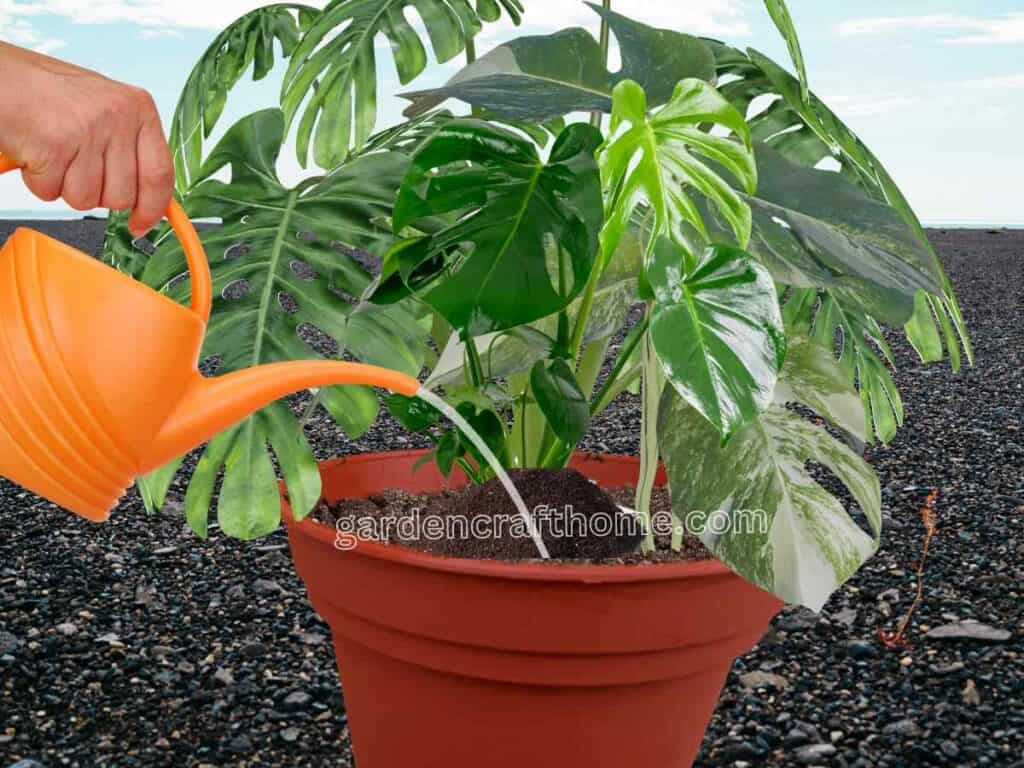Why are my monstera leaves folding? A Monstera leaves may curl due to Nutrient deficiencies, Watering issues, dehydration, pest or disease, etc.
Before, I also asked myself this question: Why are my monstera leaves curling? Why do they look crumpled and bend down? But I found a way to solve the problem.
In this article, we will talk about the effect of dehydration on the leaves of Monstera deliciosa and the 6 leading causes and treatments.
If interested, click here to learn why Monstera Leaf is dropping water. [Link]
Let’s get started.
What Is The Growth Patterns Of Monstera Leaves
Curling And Natural Unfolding
As monstera plants grow and mature, their leaves naturally curl and unfurl.
New leaves may safely emerge because of this curling process, which protects them from harm before they grow entirely.
The leaf will unfold and flatten as it ages, revealing its distinctive holes and form. This growth pattern is not to be concerned about since it is vital to the plant’s health.
Maturity And Age
As a Monstera plant ages, its old leaves may exhibit specific inherent folds or curvatures.
This type of folding is not always a sign of ill health; it might happen due to changes in plant development over time.
The Monstera’s general health should hold up as long as the more recent leaves seem healthy and exhibit the appropriate development pattern.
Why Are My Monstera Leaves Curling
Monstera leaves curly due to dehydration and a lack of water within the plant’s lymphatic system.
The primary and most obvious causes are insufficient or irregular Watering.
The soil is dry, and the Monstera’s roots no longer have water to absorb and transfer to the other organs of the plant.
But this is not the only case where leaves become limp or crumpled.
It also happens when temperatures are very high because the plant disperses water into the environment faster than it can absorb.
Or when the root system is underdeveloped or healthy enough to guarantee a sufficient water supply.
People like monstera plants because they have big, pretty leaves, but sometimes the leaves will fold or curl.
This folding could be because the plants aren’t getting enough water or air, or there could be pests around.
Monstera plant owners need to know what might be causing these problems and how to fix them to keep their plants healthy and looking good.
For example, a Monstera cutting that has not yet been appropriately rooted or a specimen affected by root rot.
Dehydration can be Divided Into Two Levels:
- The initial and light one, in which the Monstera has crumpled leaves, with the edges curved downwards.
- The advanced one in which the pressure inside the lymphatic vessels is so low that the stems collapse, giving the Monstera a drooping appearance.
Let’s now look in more detail at the three leading causes of dehydration.
Insufficient Watering Makes Monstera Curl

Watering too little is why Monstera leaves and stems curl and bend downwards.
Insufficient watering can happen because you forget to water the plant, don’t respect its water needs according to the seasons, or don’t follow its growth speed.
If interested, click here to learn how to water a monstera.
The plant grows little during the winter and needs much less water than in the summer.
The same symptoms of dehydration will take longer to manifest precisely because the plant absorbs less and perspires less.
In spring and summer, Monstera can grow very quickly. Its metabolism becomes very rapid, so it must be watered more often.
Don’t get me wrong, with this, I don’t mean that you need to leave the soil wet all the time, but that by drying more quickly, the Watering will be much closer together.
How To Fix Curling Monstera Leaves Due To Insufficient Watering
How do you fix curling monstera leaves due to insufficient Watering?
Water the Monstera abundantly to saturate the soil’s microporosities thoroughly.
These small spaces are created between the soil particles and within it.
Let the water drain freely from the drainage holes in the vase and empty any that stagnates in the saucer. and respect its water needs at different times of the year
To find everything you need to know about how to water the Monstera click Here.
Within a few hours, the plant will regain its turgidity and become as vigorous as before.
If this does not happen, continue reading because the cause could be another.
Levels Of Humidity Make Monstera To Curl
Monstera leaves are prone to curling under low humidity because they like a damp atmosphere.
Leaf curling is avoided, and healthy plant development is ensured by maintaining ideal humidity levels.
Solution: Changing the relative humidity
Environments with high humidity are ideal for monstera plants. You may use a humidifier, a nearby water tray, or misting to raise the humidity level surrounding your plant.
Monitor the humidity levels often to keep your Monstera in a comfortable environment.
Temperatures Too High Can Make Monstera Leaves Fold
If you want to know why Monstera leaves are curling, it may be that the temperature is too high; between 29-30°C or more, Monstera leaves can become limp and flaccid.
This happens because transpiration occurs so quickly that the plant cannot replenish the water within the leaf tissues.
The deficit causes the leaves to lose turgidity and end up curling up.
And everything is even more accentuated if the ambient humidity is low or the light is intense.
The plant has a trick to counteract dehydration, i.e., the closure of the stomata.
If it is true that this slows down the dispersion of water, it is also true that it limits the transport of sap from the roots to the leaves.
By doing so, the plant manages to survive the heat, but at the expense of the health of some leaves.
How To Fix Curling Monstera Leaves Due To High Temperature 🌡️
Suppose you don’t have a cooler place to put your Monstera on particularly hot days.
In that case, you can counteract dehydration by increasing the humidity in the room. This process will also help your stomata stay open.
You can spray water on the leaves and bring the plants closer together to recreate a humid microclimate among the leaves.
Or move the Monstera to a more humid room, such as the bathroom or kitchen.
If this is not enough, I recommend placing the plant in a shady place to slow down its metabolism and water needs.
Root Rot Can Make Monstera Leaves To Curl

Another cause why Monstera can have drooping stems and leaves is root rot.
The attack of pathogenic fungi compromises the functioning of the roots to the point of causing them to rot completely.
In this case, even if the soil is wet, the plant cannot feed itself, at least not as it should. Which inevitably leads to dehydration.
Usually, the first symptoms of root rot appear with yellow leaves and dark spots on the leaves.
If you want to know why monstera leaves turn yellow, click here to find the causes and cure.
Meanwhile, the roots rot inside the pot, becoming dark, mushy, and slimy.
As the infection progresses, the plant can no longer absorb water. It begins to soften and fall on itself.
How To Fix Curling Monstera Leaves Due To Root Rot
- Dig your monstera plant and carefully inspect the roots to ensure they are root rot.
- Clean the roots from the soil
- Cut off any rotten roots with sterilized scissors.
- Spray hydrogen peroxide over the entire root system to kill any remaining spores.
- Repot the Monstera in airy, draining soil.
- Don’t water for a few days to give the cuts time to heal. In the meantime, keep the plant in the shade and spray water on the leaves to help it stay hydrated.
- After 4-7 days, do the first Watering without fertilizer.
In most cases, this should be enough to combat root rot. If this were not the case, we must move on to the phytopharmacological approach and use a systemic fungicide.
Inadequate Sunlight Can Make Monstera Leaves Curl
Monstera leaves may curl due to too much sun exposure and heat stress.
In a similar vein, low light levels may hinder leaf development and result in leaf curling.
Proper lighting and temperature must be provided for your Monstera plant to flourish.
How To Fix Curling Monstera Leaves By Adjusting Light And Temperature
Ensure your Monstera plant is in a temperature-controlled space with enough indirect sunlight.
Protect the plant from drafts, vents, and bright sunlight to prevent temperature stress.
Encouraging, unfolding leaves may be maintained by keeping an eye on and modifying the light and temperature conditions of the plant.
Diseases And Plagues Can Make Monstera Leaves To Curl

Finally, curled Monstera leaves may also result from illnesses and pests.
Curling leaves may be a symptom of several plant diseases, fungal infections, and insect infestations that impact the plant’s general health and development.
Treatment And Prevention Of Illnesses And Pests
Check your Monstera occasionally for symptoms of pests or illnesses that might cause the leaves to curl.
Ascertain the general health and well-being of the plant by quickly identifying and resolving any issues.
Avoiding and curing pests and illnesses by keeping the surroundings clean, caring for plants properly, and using non-toxic therapies are possible.
Summary
In addition to the causes listed above, there are other reasons why Monstera leaves bend downwards: lack of light and excessive environmental humidity.
As mentioned in this post on guttation, the most efficient method for a plant to transport sap from roots to leaves is to take advantage of water’s cohesion and surface tension.
Briefly said,
the water that evaporates from the leaves creates a vacuum inside the stomata.
This vacuum exerts a negative pressure (a suction), which, propagating from cell to cell, “pulls” the water up along the entire xylem vascular system as if it were a rope.
If, due to the absence of light or environmental humidity, the plant cannot transpire, this system’s efficiency is lost. And Monstera leaves can droop a little.
Conclusions
As you have seen, there are 6 reasons why a Monstera can have limp stems or leaves (or floppy, soft, curled, crumpled, drooping, depending on what you want to call them), and they are:
But remember, the new leaves may fold and unfold later, so keep an eye on your Monnstera to ensure you know when they are sick.
To my suggestion, I will say you should observe if two to four leaves are coiling before taking action.
Taking good care of your monstera delicious is recommended.
For more information on caring for a monstera plan, click here.[Link]
More articles concerning Monstera.[Link]





